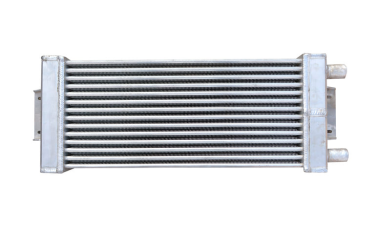Vacuum Brazing of Oil Cooler

The Vital Role of Oil Coolers in Automobiles
In modern automobiles, oil coolers are vital components designed to regulate the temperature of various lubricants such as engine oil, automatic transmission oil, and power steering fluid. As vehicles become more powerful and efficient, their engines and transmissions operate under greater thermal stress. Oil coolers ensure that these systems function at optimal temperatures by transferring excess heat from the oil to a cooling medium like water or air. The cooler is mainly composed of a bottom plate, a cover plate, a composite assembly, an oil inlet pipe, and an oil outlet pipe. Vacuum brazing in an oil cooler is used to join the composite assembly, which includes the bottom plate, cover plate, and other internal components, creating a strong and leak-proof structure essential for efficient heat transfer. Their role is crucial in preventing overheating, reducing wear and tear, and enhancing the reliability and lifespan of vehicle systems. The main materials used in oil coolers are aluminum and stainless steel, selected for their excellent thermal conductivity, corrosion resistance, and structural strength. Common types of oil coolers found in automobiles include plate-fin oil coolers, disc oil coolers, box-type oil coolers, laminated integral oil coolers, tube-fin oil coolers, transmission oil coolers, and fuel coolers.
The Importance of Vacuum Brazing in Oil Cooler Production
To manufacture these advanced and compact oil coolers, vacuum brazing has become the preferred joining method due to its unique technical advantages. Developed in the 1940s and applied to stainless steel plate-fin heat exchangers by 1959, vacuum brazing enables strong, clean, and flux-free joints with excellent thermal conductivity. It allows manufacturers to bond thin metal components with complex internal structures like those found in laminated or plate-fin oil coolers without introducing contaminants. Vacuum brazing is now standard in the production of automotive heat exchangers, with some vehicles containing over 20 vacuum-brazed components. The method not only improves structural integrity and heat transfer efficiency but also supports the industry's push toward lightweight, durable, and space-saving thermal solutions.
Normantherm: Advanced Vacuum Brazing Solutions for Automotive Oil Coolers
Normantherm, a leading manufacturer of vacuum brazing furnaces with over 15 years of expertise, plays a crucial role in supporting the automotive sector's oil cooler production. To support the growing demand for high-performance oil coolers, Normantherm offers its advanced VF Series vacuum brazing furnaces, tailored to precise thermal and material requirements.
The VF Series includes models such as VF 1300-422 (400×200×200 mm), VF 1300-644 (600×400×400 mm), VF 1300-966 (900×600×600 mm), and VF 1300-1288 (1200×800×800 mm), each capable of reaching temperatures up to 1300 °C with precise vacuum control. These furnaces are designed to meet the strict performance, pressure, and corrosion-resistance demands of modern automotive applications. Whether you’re producing aluminum or stainless steel oil coolers, Normantherm’s customizable vacuum furnace systems help manufacturers achieve optimal brazing quality, long-term reliability, and compliance with evolving vehicle performance standards.
Editor: Sahera Khatun
Copyright: Normantherm Vacuum Brazing Furnace
